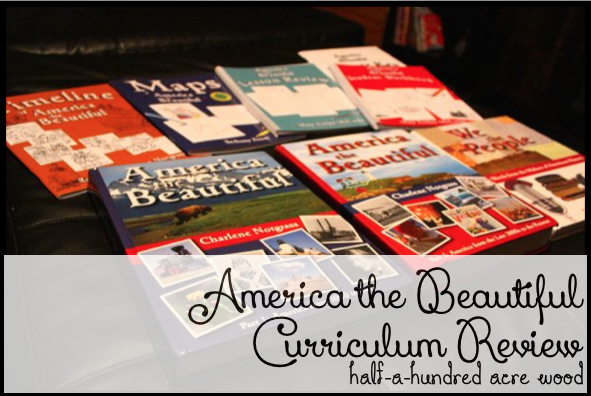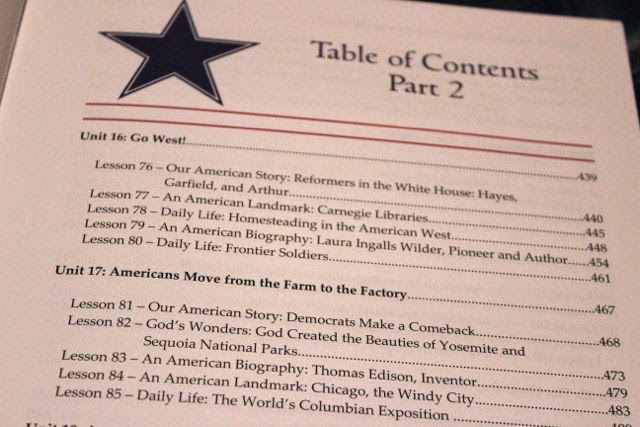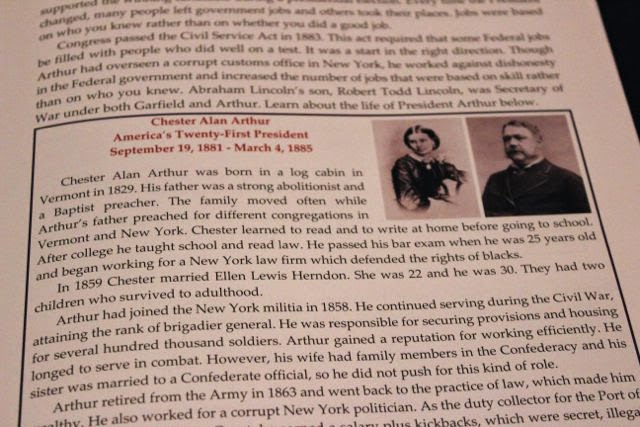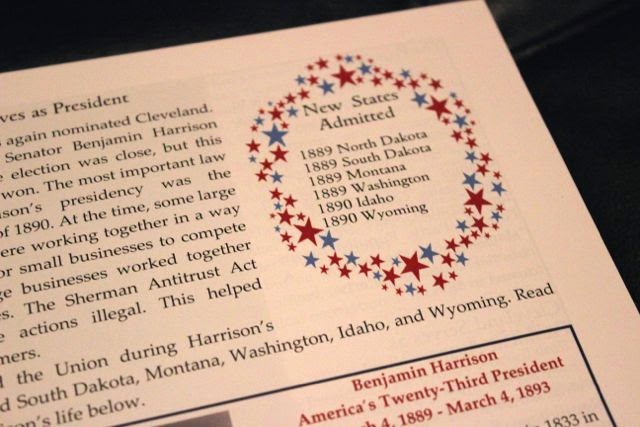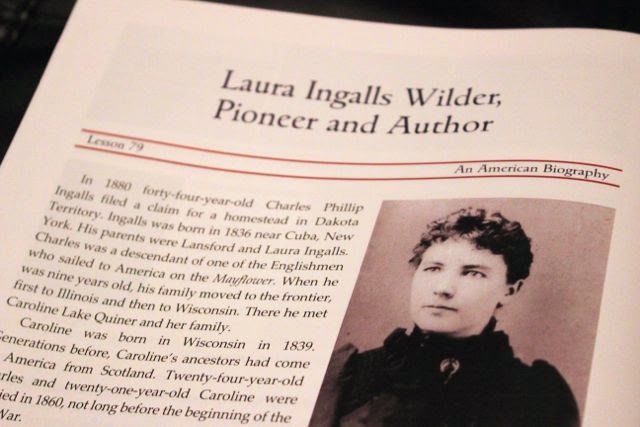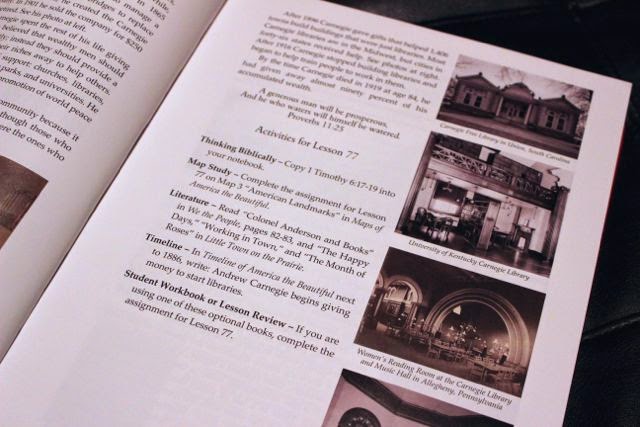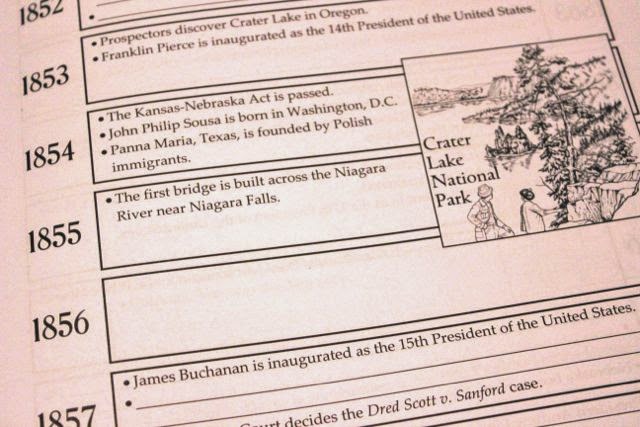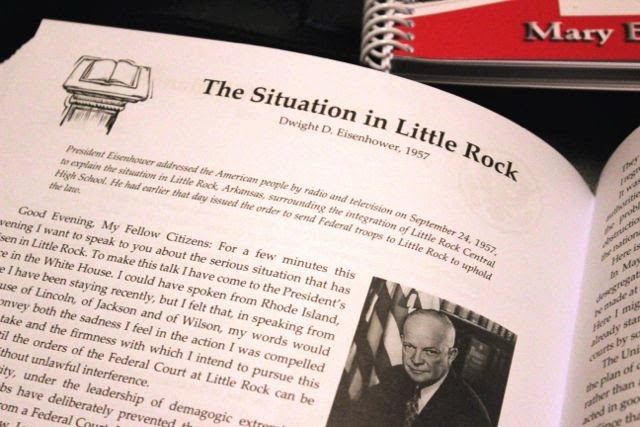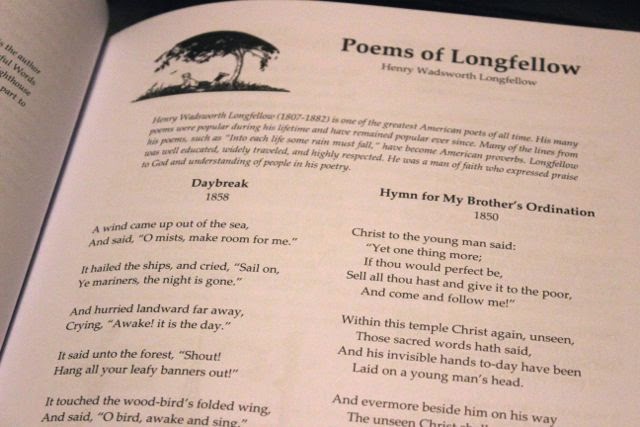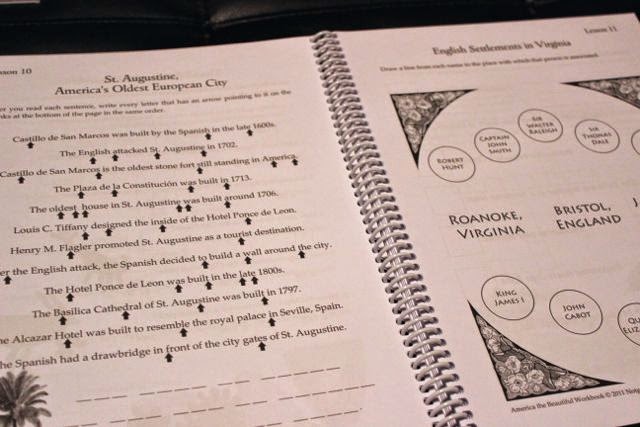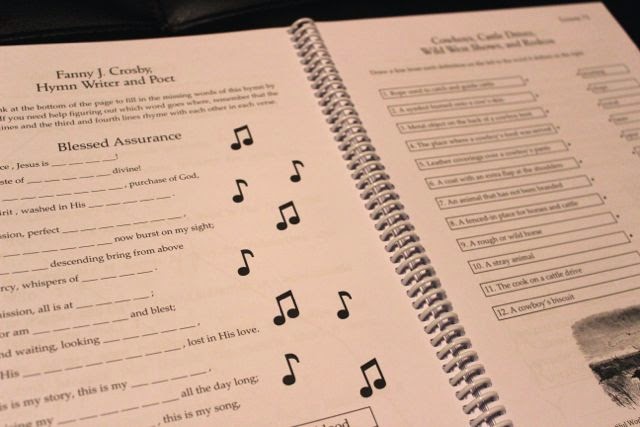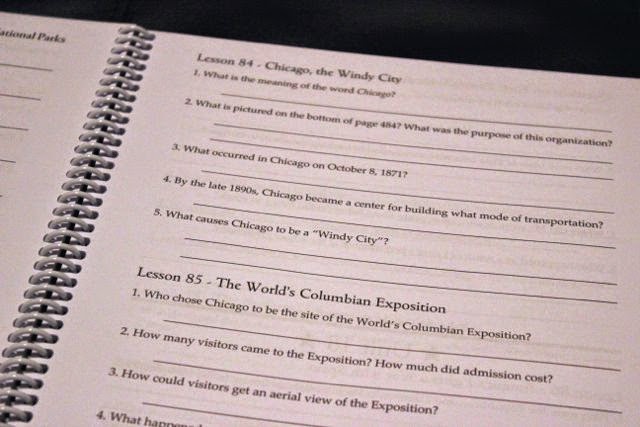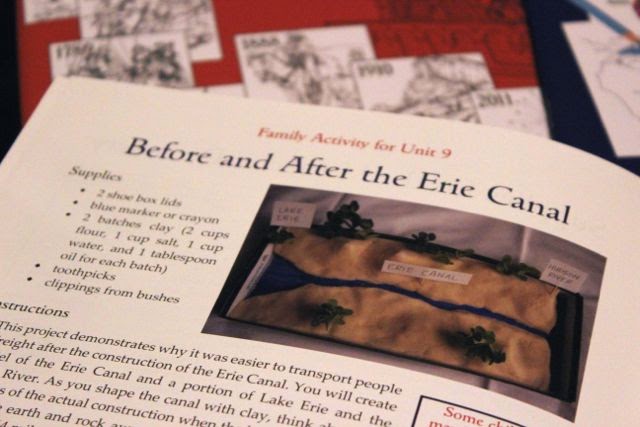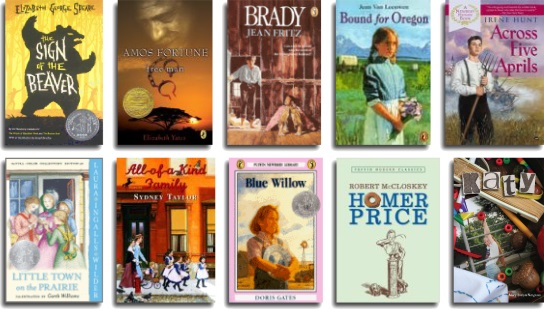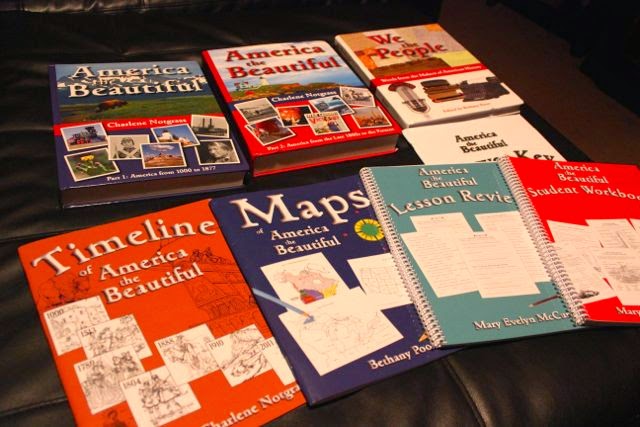Every time we cycle back through a year of U.S. History study, I usually piece together an assortment of various books and activities from different curriculum companies and websites based on my children’s interests. This year our family is trying out a one-year study of American history that is chronological, complete, and simple to use. In fact, it is the easiest-to-follow one-year U.S. history study I have come across for elementary-aged children.
America the Beautiful is a one-year American history, geography, and literature study from the Notgrass Company consisting of seven parts:
- America the Beautiful Part 1 and America the Beautiful Part 2 (history text)
- We the People (primary source text)
- Maps of America the Beautiful
- Timeline of America the Beautiful
- Lesson Review
- Student Workbook
- Optional Literature Study
The best way to describe this is to open it up to show you each piece, so without further ado, let’s take a trip through America the Beautiful.
America the Beautiful Part 1 & 2
The America the Beautiful text is divided into two hardcover books each composed of 75 lessons (30 units with 5 lessons each). The first book begins with life in America before the arrival of the Europeans and continues through the Civil War. The second book begins with America’s westward expansion and continues through modern days.
Each unit is divided into five lessons, which are quick evening read alouds for our family:
1. Our American Story, which covers major events from the time period of the unit, including biographical insets of each U.S. President placed in the context of the events in which they lived
and even a note/illustration providing the states which were added to the union. (Details like this are so helpful!)
2. An American Landmark that relates to that time period. Here we read about the history of and interesting facts about an important site in American history, such as Carnegie libraries.
3. God’s Wonders, which points out the wonders of God’s creation across America. (This is one of my favorite parts about this study of American history! We get to “travel” the United States without ever packing our bags!) Here we explore national parks and other sites through photographs and illustrations as we learn about them in a historical context.
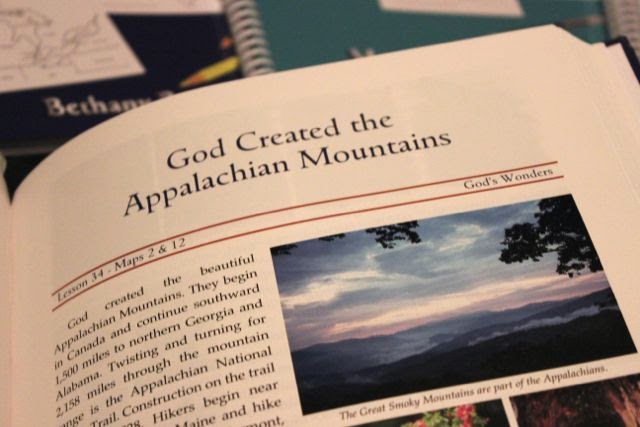
4. An American Biography about a person who lived during the time period being studied (which includes poets, composers, inventors, authors…)
5. Daily Life, which explains how people lived and worked during that time period.
Each lesson closes with a Bible verse and a list of approximately five (optional) activities that may be used to further explore and retain the information presented in the lesson.
These optional activities include…
- a Bible lesson, which is usually in the form of copywork or a writing prompt reflecting on a scripture that somehow ties into the lesson
- vocabulary study
- creative writing prompts
- adding an event to the Timeline of America the Beautiful book, an illustrated timeline of U.S. history from AD 1000 to the present day, which correlates specifically to each lesson. (Click here to view sample pages.)
- map activities from the Maps of America the Beautiful book, a collection of maps used to study the geography pertaining to each lesson. (Click here to view sample maps.)
- additional reading assignments from We the People, a collection of poems, songs, speeches, letters, journal entries, newspaper articles, advertisements, and other historic documents from American history. (Click here to view sample pages.)
- assignments in the Student Workbook (intended for upper elementary-aged children), such as crosswords, word seeks, codes, drawing assignments and other creative ways to review the lesson. (Click here to view Sample Activities.)
- or assignments from the Lesson Review (intended for middle school students), which includes daily questions, weekly quizzes, and literature review questions.
- At the end of each unit is a special family activity, such as a recipe, or craft/art project that demonstrates something related to the unit.
- Finally, there’s also an Optional Literature Study which consists of ten works of literature that correlate to various time periods studied within America the Beautiful. The books include The Sign of the Beaver by Elizabeth George Speare, Amos Fortune: Free Man by Elizabeth Yates, Brady by Jean Fritz, Bound for Oregon by Jean Van Leeuewn, Across Five Aprils by Irene Hunt, Little Town on the Prairie by Laura Ingalls Wilder, All-of-a-Kind Family by Sydney Taylor, Blue Willow by Doris Gates, Home Price by Robert McCloskey, and Katy by Mary Evelyn Notgrass. (Comprehension questions are included in the Lesson Review book above.)
How It Fits in for our Family
In elementary school, our family focuses primarily on what I call the 4 Rs: Reading, ‘Riting, ‘Rithmetic, and Recitation. Anything else we do beyond that is interest-led and child-driven (and is used to develop presentation skills). So, the first question I must ask myself is… can it be used to emphasize the core skills (the 4Rs)? The second question I must ask is… do my children want to use it?
The answer to the first question is yes. This curriculum emphasizes reading and writing. Even without the additional literature package, students are led through American biographies, landmarks, historical sites, and the reading of multiple primary-source texts (such as letters and journal entries), as well as poetry and stories. A variety of reading is offered within the basic curriculum package that comprises America the Beautiful.
The answer to the second question is yes. When we first opened the box, our six-year-old asked me if these could be his books. He loved the photographs and illustrations, and he enjoyed hearing about the animals and places of the United States. Our eleven-year-old wanted to start the map and timeline activities as soon as possible, and our eight-year-old asked me to just keep on reading. So… at the request of my children, we are using America the Beautiful for the remainder of this year. Because we are midway through our one-year cycle of American history, we are starting with Book 2 this year. When we return to our American history studies again in three years, we may end up using this as our core reading package for the year.
What else do we like about America the Beautiful?
God-centered. All of the lessons point back to Biblical truths, reflections, and applications for life. It makes the study of history that much more purposeful.
Integrated subjects. Not only do we study history, we get to explore national parks, unique cities, and American landmarks. We learn about composers, authors, and poets. It all ties back to God. Bible, geography, literature, biographies, history, and even some science are combined together into one story about America’s history.
User-friendly, easy-to-follow layout. The lessons may be used as a family read aloud, or the child can read the lessons on his own. All of the instructions for using America the Beautiful are incorporated into the America the Beautiful Part 1 and Part 2 books and are simple enough that older students can work independently if needed.
Easy to implement. Most of the follow-up activities are quick, simple, enjoyable, interesting, and doable. The work is not overwhelming, nor is the amount of reading.
All of our children like it. Don’t let the fact that it states an age range deter you. Although it is advertised as designed for children in grades 5-8, even our kindergartner has enjoyed the readings, map studies, and timeline coloring. All of our school-aged children (ranging from grade K to 6) have enjoyed the readings in this book.
As exciting as a unit study. The variety of activities offers a feel of a unit study without being complicated. The family activities emphasize worthwhile projects that will not only provide extra learning opportunities but also build family memories.
(Note: For users of Classical Conversations, America the Beautiful correlates to every history sentence in Cycle 3 and to many of the physical feature studied in Weeks 11-24.)
Freebies: Don’t just take our word for it. Use it yourself!
The Notgrass family provides generous samples of their curriculum on their website! For America the Beautiful, they offer two complete units along with the corresponding maps, timeline, and student workbooks for you to download and try America the Beautiful in its entirety before you ever make a purchase!
To download an entire unit (President Polk and Manifest Destiny, Oregon Trail, Niagara Falls, and John James Audobon) from America the Beautiful Part 1 and an entire unit (life in and history of the 1950s, Brown v Board of Education, Norman Rockwell, and Alaska) from America the Beautiful Part 2, along with corresponding sample questions, activities, timeline, and maps from each of the other books, visit Learn about America the Beautiful and scroll down to the area highlighted in blue. You can also download the literature study questions for free here!
While you’re on the Notgrass website, be sure to sign up for the Notgrass bimonthly email newsletter to receive free videos and field trip ideas!
Bottom line: This is one the best one-year American History curriculum options I have come across for elementary-aged children. (Even Stephen says it’s a tie with the Homeschool in the Woods Time Travelers studies, which is saying a lot!)

